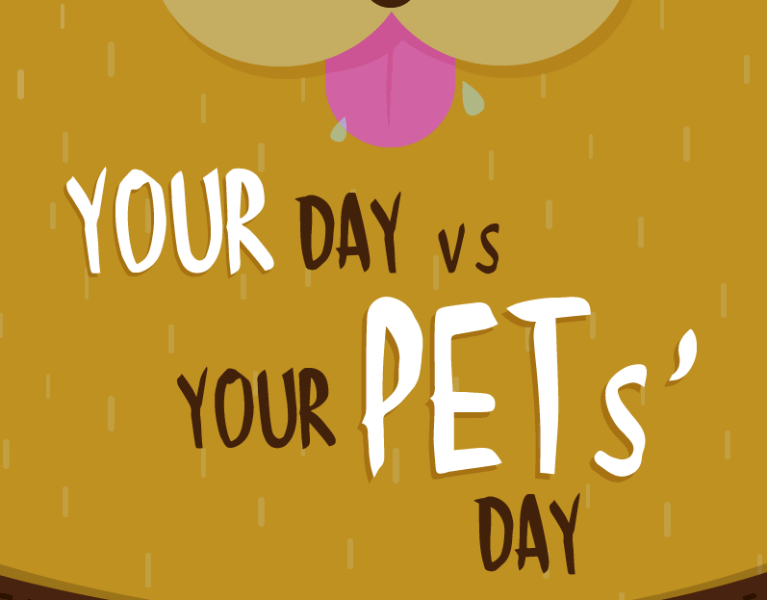The UK is a nation of animal-lovers with 44% of the population owning a pet. Dogs (to the outrage of cat-people everywhere) are the most popular pet, with 24% of people owning at least one. This is closely followed by cats (17%), and, surprisingly, fish (8%).
As much as we’d all love to sit at home all day playing with our beloved pets, unfortunately the real world is calling. We have jobs and social lives which we need to leave the confines of our homes, and the cuddles of our pets, to go and deal with. But have you ever found yourself sitting in the third meeting of the day wondering what exactly your pets are up to? What are they thinking? What are they doing? Do they miss you? We sure have…
Find out what we suspect your pet gets up to once the front door shuts behind you in the morning:

Share this Image On Your Site
What Do Dogs Do All Day?
Like children, what your dog gets up to whilst you’re away largely depends on their personality. Some will simply snooze the day away, alternating between napping and eating, eating, and napping. Other, more mischievous characters might take the opportunity to partake in a bite of the forbidden fruit; climbing on furniture, rolling around on the carpet, drinking from the toilet, scaring the postman…
Typically, though, dogs often spend 50% of a day sleeping, an additional 30% just lying around, and a mere 20% being active. Sounds like our kind of day…
Is It OK to Leave Dogs Home Alone?
Dogs are, by their nature, social creatures. They are sentient beings with emotions that are very similar to ours and, like us, may find it hard to adjust to being the centre of attention one moment and then left completely alone the next. For this reason, dogs need to be trained to be okay with being left home alone.
If you’re raising a puppy, be sure to build up their tolerance for alone time slowly. A young pup shouldn’t be left alone for more than an hour or so whilst adult dogs (18 months and up) are typically able to tolerate between four and seven hours alone. Puppies should be left in a spacious, comfortable crate or puppy-proofed room to keep them safe and secure.
Some other things that you can do to keep them happy and comfortable whilst you’re out of the house include taking them for a little walk in the morning (so they can stretch their legs and relieve themselves), provide them with a comfortable dog bed (perhaps with a jumper or blanket that smells of you), and give them a puzzle toy to keep them entertained. Some dogs may also find the radio soothing, especially if you tend to have music playing whilst you’re at home.
Some pets may suffer particularly badly from separation anxiety. The stress may result in them leaving you a mess to clean up when you get home. Your pet isn’t doing this on purpose; they can’t express their emotions like a human, and going to the toilet is an act of relief. In addition to this, chewing, or destructive behaviour, may be a manifestation of their boredom or be a soothing act, like a child sucking their thumb.
The Woodgreen Animal shelter make some great suggestions for how to ease separation anxiety in your dog.
What Do Dogs Think About?
Studies have shown that dogs have the cognition of a two-and-a-half to five-year-old child. They also experience optimism, happiness, anxiety, fear, depression, love, and emotional pain, just like us.
Further studies have revealed that dogs do love us back; they see us as a family and a source of protection, reward, and sustenance. They can interpret our facial expressions, sounds, and even smells, and react accordingly.
But when we’re not in the room, we highly suspect that they spend their time thinking about food, trying to identify the different smells around your home, tennis balls, sticks, you, tennis balls, cats, you…
What Do Cats Do All Day?
Do we ever really “own” a cat or are we, in fact, just their two-legged servants? Whether you believe that you own your cat, or your cat owns you, have you ever wondered what they get up to when you leave the house, or when they don’t come home for a day?
The truth is that cats generally spend most of the day asleep. In fact, cats sleep, on average, for fifteen to sixteen hours a day, and then have the audacity to spend another four to six hours resting. That’s nearly twenty-two hours of sleep or rest. Short of strapping a GoPro to your cat and leaving them to it (we don’t really recommend this, especially if you have a cat that goes outdoors) we’ll never really know what they get up to in a day.
In the two hours that they spend awake, we suspect that they spend their time plotting and scheming, and thinking up new ways to remind you that you are only on the planet to serve them. They’ll probably also spend some time playing, eating, climbing on your furniture (and computers), and running crazily from room to room, as this timelapse of a cat’s day shows.
Why Do Cats Sleep All Day?
Cats are crepuscular, which means they’re at their most active around dawn and dusk. This is because they have the physiology of a predator meaning that they’re hardwired to lay low during the day time to avoid predators, and to wake up to hunt at night.
Whether it’s a stuffed toy, sock, or innocent mouse, hunting takes up a lot of energy, so they need to recharge regularly to be able to stalk and pounce with accuracy.
Outdoor vs. Indoor Cats
A study which fitted fifty house cats with cat cams that took a photo every fifteen minutes for a full day revealed that “about twenty-two percent of the cats’ time was spent looking out of windows, twelve percent was used to interact with other family pets, and eight percent was spent climbing on chairs or kitty condos. Just six percent of their hours were spent sleeping”. In addition to this, cats spent a further six percent of their time looking at a television, computer, DVDs or other media, and were hiding under tables six percent of the time, too. Playing with toys accounted for just 5 percent of their time whilst looking at, or eating, food clocked four percent.
On the other hand, a study conducted by the University of Illinois which fitted radio-tracked collars to 42 cats (some with owners, some strays) and found that they roamed a collective area of 6,286 acres, though many never strayed further than 300 metres from human structures such as buildings; so even though they may act aloof, they do depend on us. The study also revealed that “owned cats” only engaged in vigorous activity such as running or stalking just 3% of the time, whilst the strays spent 14% of their time in activity, due to a lack of food provided by an owner.






